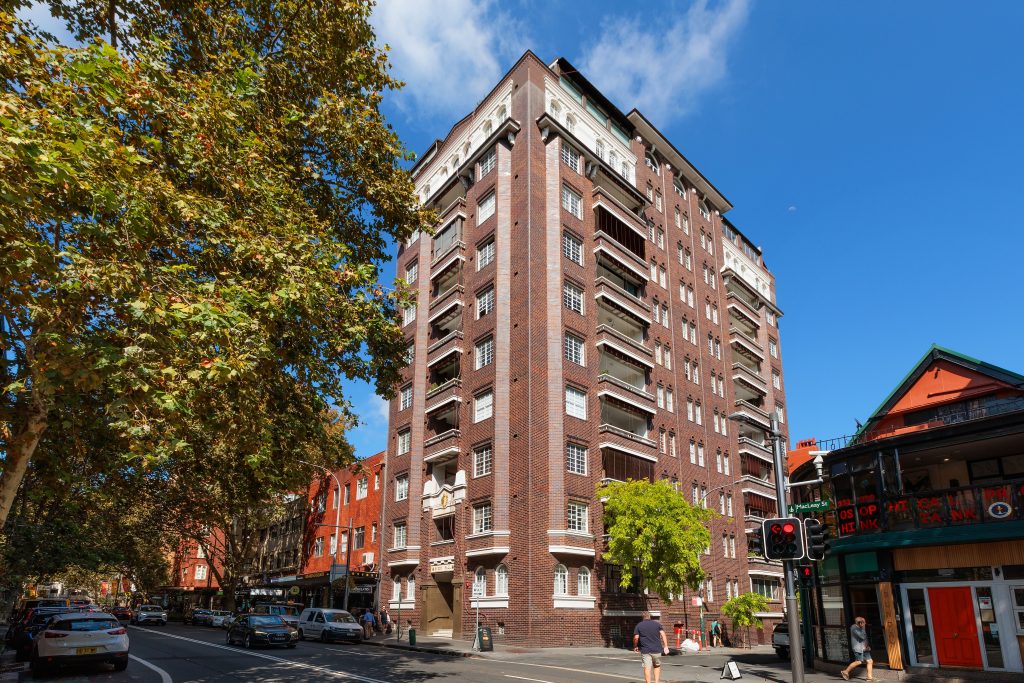APARTMENT 18, BYRON HALL, 97-99 MACLEAY STREET, POTTS POINT

Byron Hall is one the area’s most noble apartment blocks.
Apartment 18 is for sale through Jason Boon, Geoff Cox and Joss Reid https://www.rwebay.com.au/7566083/
It was built by Claud Hamilton, that’s Claud without an e, a prolific early 20th century architect/developer in the “inter-war classical free style”. He lived in Elizabeth Bay
The architectural term denotes use of classical features such Roman arches, proportionally squared windows and even a gold leaf palmette acroterion (a Grecian sculptural embellishment) emblazoned on its façade.
Byron Hall is a distinguished embellishment in its streetscape.
Its free, eclectic style was popular between 1919-1939. It was less formal than former 18th and 19th century buildings which had also adopted some neo-classical elements.
The provenance of the name Byron Hall is unknown.
Claud Hamilton was also an inventor apart from designing about 15 apartment blocks in the area including nearby Regent’s Court in Springfield Avenue (1925), the Savoy apartments (1919), St John’s Flats, Darlinghurst Road (1916), Wirringulla (1927) and Kaloola (1927), both in St Neot Avenue, Normandy House, Darlinghurst Road (1916), Versailles (1926) and Kenilworth (1920) amongst others. He was described as a “reknowned architect of the day” and born in Campbelltown, a small town on the southern tip of the south island of New Zealand.
He also built a large number of properties in Lithgow, the Blue Mountains and “Arawua” (1935) at 6 Palm Beach Road, named after the Awarua Plains, NZ, where he was raised.
His King Street offices must have been very busy.
Apartment 18 has many original features including its window frames, air vents, mottled glass, high ceilings and period architraves.
Hamilton’s professional relationship and commercial partnership with the developer of Byron Hall, Mr. James, soured. It created a legal case which ended up in the High Court of Australia. They had both agreed to buy the site in August 1926 for £11,250 to build flats. They formed a company designed to hold the property and profits in trust for each of them based on a fair split of their individual investments. But costs went over the budget of £45,000 and a dispute arose. How much profit should each now receive? Was the original contract still binding? No, said the High Court unanimously in 1930; they were “co-adventurers” [case reference HCA 8, 45 CLR 37]. Hamilton was thus directly entitled to his full share of the profits based on their original but loose “arrangement”, ie., based on 40% of his costs, regardless of cost overruns.
Until the 1950s Byron Hall was serviced self-contained flats, all owned by Mr. James.
Maids lived on the top floor and a caretaker resided on the ground floor, where original wooden letterboxes with gold numbering are still used. The original foyer name board still exists in the board room.
When ‘flats’ first became popular there were serious doubts about their convenience and sustainability. Some owners had experienced problems with flats in other buildings but on the 2nd June 1943 The Sydney Morning Herald reported that “Mr. W.H James, owner of Byron Hall Flats, Potts Point, yesterday denied that he, like some other owners of flats, had experienced any shortage of coal to provide central heating and a hot water supply there for the 43 flats. Mr. James said that hot water was supplied without interruption and for central heating between 6am and 8am and 4pm and 10pm.”
After the High Court case in 1927 he ran into more financial complications and took legal action successfully settling a case for £137/10 owed to recover his costs against a real estate agent, Vincent Morgan, for work on a proposed block of apartments at Baden Street, Coogee.
And another legal case followed.
In 1940 Smith’s Weekly reported he owed £50 to Sydney Council and had failed to pay. Council petitioned for his bankruptcy in November 1940 and won the case.
He was then bankrupt.
On 22nd May 1943 the Sydney Morning Herald reported he had died, aged 52: “A Sydney architect, Mr. Claude Hamilton of Elizabeth Bay, died yesterday after a long illness. He was well-known as the inventor of a plastic cement building material and built a large number of houses at Lithgow of this material. Mr Hamilton supervised a number of constructions for Australian Consolidated Industries and designed and constructed a large number of flats at Kings Cross.
He is survived by Mrs. Hamilton, three daughters and a son.”
Byron Hall is one of his enduring legacies.
By Andrew Woodhouse
Heritage Solutions





